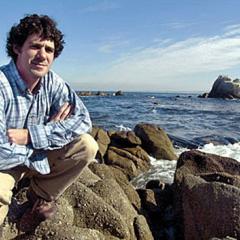Rafe Sagarin profiled in Stanford Magazine article "Tide Pools & Terrorists"
Nearly two decades after coming to the Hopkins Marine Station as an undergraduate in earth systems, Raphael D. Sagarin was again hunched over a tide pool identifying its briny inhabitants. His mentor, emeritus lecturer Chuck Baxter, stood on a nearby outcropping and called out helpful advice.
It was a drippy coastal morning, with fog heavy enough to dampen paper and a raucous crowd of gulls hooting from the roof of the nearby lab. The shallow pools initially appeared abandoned at low tide, but a closer look revealed dozens of tiny creatures going about their underwater business.
"Those are mostly hermit crabs taking over turban snail shells," Sagarin, '94, said, as he peered into one pool. He pointed to a pair of spongy green blobs. "Anthopleura sola, that's those two anemones."
Tabulating the creatures of the Monterey tide pools had been the modus operandi of a study Sagarin began in 1993, which became one of the first to show that climate change was transforming a regional ecosystem. It rooted his faith in observational ecology—the old-fashioned naturalist style of closely watching and meticulously calibrating the world in order to understand it.
Rafe Sagarin has since taken that methodology to much stranger tide pools. Now an assistant research scientist at the University of Arizona, Sagarin has turned his observational focus to questions of national security: How can people adapt to changing conditions using evolutionary principles? His work, which now involves collaboration with military and government officials as well as with fellow scientists, asks what humanity can learn from nature when dealing with complex uncertainties, like natural disasters or terrorism.
